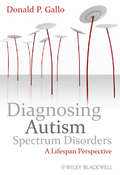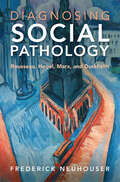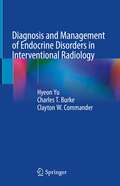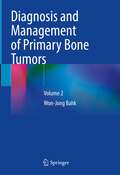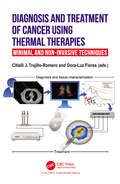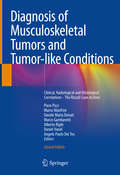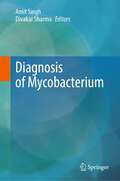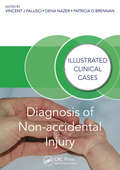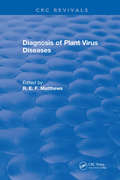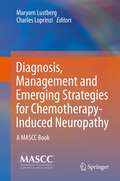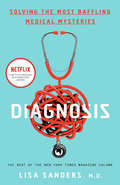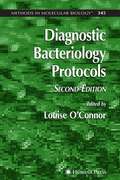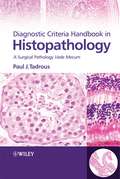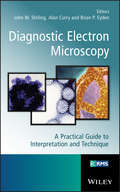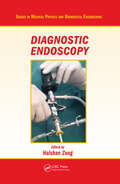- Table View
- List View
Diagnosing Autism Spectrum Disorders
by Donald P. GalloDiagnosing Autism Spectrum Disorders: A Lifespan Perspective is the first book of its kind to provide authoritative information for medical and mental health professionals on how to properly evaluate and diagnose autism spectrum disorders in individuals of all ages. The first book of its kind which demonstrates how to conduct an appropriate diagnostic interview to assess a child for an Autism Spectrum Disorder Considers the issues of Autism Spectrum Disorders in children, teenagers, and adults Aimed at both medical and mental health professionals Includes an in-depth treatment of the entire diagnostic process
Diagnosing Hemp and Cannabis Crop Diseases
by Dr Shouhua WangHemp and cannabis, both belonging to Cannabis sativa, have emerged as some of the most valuable crops because of their multiple functionalities - industrial, medicinal, and recreational uses. Like all other crops, they are at risk of diseases and pests. In certain cases, an entire hemp field can fail due to unexpected disease. As a new and highly regulated crop, research on Cannabis crop diseases is scarce, and the science of plant diagnostics is not well covered in the literature. Taking hemp/cannabis as a model crop, the book illustrates how to diagnose a disease problem and how to manage it effectively. It presents real disease cases encountered during crop production, and explains methods of diagnosis, both in the field and in the lab, in order to find out the cause(s). The book provides: ·A field and laboratory guide to diagnosing hemp and cannabis diseases and pest problems ·Ready-to-adopt skills, methods and protocols in plant diagnosis, which can be applied to other crops ·Over 300 colour photographs accompanied by a wealth of disease information, including field observations, unique symptoms, microscopic details, and molecular data. This book is essential for anyone who is interested in learning about Cannabis crop diseases, for crops grown in the field, and in indoor production facilities.
Diagnosing Learning Disorders, Second Edition
by Bruce PenningtonFrom a trusted expert in the field, this authoritative work provides an accessible overview of what learning disorders are, how they develop, and how to diagnose and treat them effectively. The author presents the most current neuroscientific knowledge on a range of conditions, including dyslexia, autism spectrum disorders, attention-deficit/hyperactivity disorder, and others. Practitioners gain vital insights and tools for making sense of children's impairments and strengths, collecting and interpreting diagnostic data from a variety of sources, and linking diagnosis to evidence-based interventions. The second edition has been substantially revised and expanded to reflect significant clinical and research advances. New to This Edition Covers additional disorders intellectual disability, mathematics disorder, and developmental coordination disorder, plus a chapter on less well-validated disorders. New case illustrations and a focus on empirically based practice. Now grounded in a multiple cognitive-deficit model of learning disorders, replacing the prior edition's modular, single-deficit model. An illuminating chapter on controversial therapies separates myths from facts.
Diagnosing Learning Disorders, Third Edition: From Science to Practice
by Bruce F. Pennington Lauren M. McGrath Robin L. PetersonA definitive reference--now extensively revised with 70% new material--this book presents cutting-edge knowledge on how learning disorders develop and how to diagnose and treat them effectively. In additional to dyslexia and mathematics disabilities, the book covers speech and language disorders, attention-deficit/hyperactivity disorder, autism spectrum disorder, and intellectual disability. Accessibly written, it is grounded in genetics, neuroscience, and developmental neuropsychology. Clinicians and educators are guided to make sense of children's impairments and strengths and make sound diagnostic decisions. Best practices in intervention are reviewed. User-friendly features include case examples and summary tables in each disorder-specific chapter. New to This Edition *Revised throughout to reflect major theoretical, empirical, and technological advances. *Chapters on etiology, brain development, and comorbidity. *Chapters on DSM-5 diagnosis of specific learning disorder, evidence-based assessment, and achievement gaps.
Diagnosing Social Pathology: Rousseau, Hegel, Marx, and Durkheim
by Frederick NeuhouserCan a human society suffer from illness like a living thing? And if so, how does such a malaise manifest itself? In this thought-provoking book, Fred Neuhouser explains and defends the idea of social pathology, demonstrating what it means to describe societies as 'ill', or 'sick', and why we are so often drawn to conceiving of social problems as ailments or maladies. He shows how Rousseau, Hegel, Marx, and Durkheim – four key philosophers who are seldom taken to constitute a 'tradition' – deploy the idea of social pathology in comparable ways, and then explores the connections between societal illnesses and the phenomena those thinkers made famous: alienation, anomie, ideology, and social dysfunction. His book is a rich and compelling illumination of both the idea of social disease and the importance it has had, and continues to have, for philosophical views of society.
Diagnosis and Management of Endocrine Disorders in Interventional Radiology
by Clayton W. Commander Hyeon Yu Charles T. BurkeThis book provides a comprehensive guide for selective venous sampling procedures and the role of interventional radiologists in the care and treatment of patients with endocrine disorders. Disorders of the endocrine system involve an imbalance in the natural homeostasis of the hormones produced by the glands in the body. There are a variety of endocrine conditions that are characterized by either hormonal hyposecretion or hypersecretion. Percutaneous selective venous sampling is the gold standard diagnostic tool for the medical and surgical management of patients with a variety of such disorders. Selective venous sampling is a minimally invasive interventional procedure that interventional radiologists perform to localize sites of abnormal hormone secretion. Computed tomography and magnetic resonance imaging are the most used diagnostic imaging modalities in patients with the suspected endocrine disorder; however, their specificity is not optimal, and identifying a culprit gland is difficult based on imaging findings alone. Therefore, the ultimate decision for management depends on the outcome of selective venous sampling. As these various venous samplings are increasingly performed worldwide, the collaboration between interventional radiology, endocrinology, surgical endocrinology, surgical oncology, neurosurgery, and gynecology teams is essential. With limited literature on the topic, this volume fills the gap with in-depth coverage of selective venous sampling alongside the pathophysiology, epidemiology, clinical diagnosis, as well as medical, surgical, and interventional management of endocrine disorders. The book is divided into five parts: Clinical, Laboratory, and Radiological Diagnosis of Endocrine Disorders; Selective Venous Sampling in Interventional Radiology; Medical Treatment of Endocrine Disorders; Surgical Treatment of Endocrine Disorders; Interventional Treatment of Endocrine Disorders. Throughout these parts, endocrine disorders that require venous sampling are covered in depth: primary aldosteronism, primary hyperparathyroidism, Cushing’s disease, hormone-secreting pancreatic adenomas, and androgen-secreting ovarian tumors. There is additionally an emerging role for interventional management in thyroid gland disorders, which is covered here. This is an ideal guide for interventional radiologists caring for patients with endocrine disorders, as well as endocrinologists, endocrine surgeons, surgical oncologists, otolaryngologists, neurosurgeons, gynecologists, and nephrologists.
Diagnosis and Management of Primary Bone Tumors: Volume 2
by Won-Jong BahkThis book is the second in a two-volume set that offers comprehensive guidance on the diagnosis of bone tumors based on a modification of the WHO classification as well as management and follow-up. The emphasis throughout is on an integrated approach to diagnosis that highlights the role of clinical, radiologic, and pathologic correlation in reducing the possibility of diagnostic error. The diagnosis of bone tumors is difficult for a variety of reasons, including the numerous types of the tumors with variable subtypes, the protean radiologic manifestations and the variable pathologic findings case by case and even depending on the phase in each case, the presence of reactive changes to the tumor lesion, and overlapping findings between benign and malignant tumors. In addition, it is often more difficult by surgeon’s inadequate biopsy. The author’s aim is to offer the readers the best possible guidance in negotiating these difficulties. For each tumor types, a wide range of cases are presented, from the common to the very rare. Appearances on the full range of imaging studies are illustrated, including conventional radiographs, bone scans, CT scan, MRI, and even PET/CT scans in malignant cases. Attention is also drawn to the role of long-term follow-up radiographs in ensuring correct diagnosis and management. This book will be an ideal resource for all practitioners and researchers who involved in bone tumor diagnosis and also management. Volume 2 covers osteoclastic giant cell-rich tumors, hematopoietic tumors, notochordal tumors, cysts and cyst-like lesions, vascular and neurogenic tumors, and tumors of other mesenchymal cells.
Diagnosis and Robust Control of Complex Building Central Chilling Systems for Enhanced Energy Performance
by Dian-Ce GaoThis book discusses enhancing the overall energy performance of building central air-conditioning systems through fault diagnosis and robust control strategies. Fault diagnosis strategies aim to determine the exact cause of problems and evaluate the energy impact on the system, while robust control strategies aim to manage chilled water systems to avoid the occurrence of low delta-T syndrome and deficit flow problems. Presenting the first academic study of the diagnostic method and control mechanism of “small temperature difference syndrome”, the book describes the highly robust and adaptive fault-tolerant control method developed to overcome the influences of external disturbance on the process control in practical applications. The diagnostic technology developed provides a predictive assessment of the energy dissipation effect of the fault. This book is a valuable reference resource for researchers and designers in the areas of building energy management and built environment control, as well as for senior undergraduate and graduate students.
Diagnosis and Treatment of Cancer using Thermal Therapies: Minimal and Non-invasive Techniques
by Dora-Luz Flores Citlalli J. Trujillo-RomeroNew research is being conducted in the diagnosis and new treatments of cancer that has high efficacy and are minimally invasiveness. Artificial intelligence, bioimpedance, thermal images and nanomaterials have been used to provide early diagnosis. New treatments based on the generation of microwaves, radiofrequency, or ultrasound have been proposed in the last couple of decades. Although thermotherapies have been shown to be efficient, for them to be considered as a primary treatment, they must overcome some hurdles. One of the main challenges is to ensure applicators that point the electromagnetic or the mechanical waves at a tumor, don't affect the surrounding healthy tissues. In some cases, nanoparticles have also been designed to achieve better focus. The design of new applicators can be made by computational models based on methods such as the finite element. However, to efficiently predict the applicator’s performance, it is important that dielectric, thermal, and acoustic properties (tissue characterization) are included in the models. Not only healthy tissue, but also tumors must be characterized. Patient specific treatment planning, which consists of a 3D patient model based on medical images, can be developed to implement a safety treatment. Moreover, tissue properties as well as the applicator must be defined. Parameters such as temperature increase, and heat pattern must be evaluated to ensure patient safety and treatment success.
Diagnosis of Musculoskeletal Tumors and Tumor-like Conditions: Clinical, Radiological and Histological Correlations - The Rizzoli Case Archive
by Piero Picci Marco Manfrini Marco Gambarotti Daniel Vanel Davide Maria Donati Alberto Righi Angelo Paolo Dei TosThis book, now in a second revised edition, casts light on the often complex diagnosis of musculoskeletal tumors and tumor-like conditions by drawing on the experience of the Rizzoli Orthopedic Institute during more than 100 years of treatment and research in the field. The different entities are described from a multidisciplinary perspective, highlighting clinical, radiological, and histological correlations. Particular emphasis is placed on differential diagnosis, which often needs to take into account nontumoral conditions. The recent identification of further significant biological and genetic features, and the impact of these discoveries on the classification of round cell tumors, vascular lesions, and spindle/pleomorphic entities in bone, is also extensively discussed. The Rizzoli case archive dates back to September 1900 and contains the original material relating to more than 29,000 bone lesions and 11,000 soft tissue lesions. It is a fabulously rich resource, and this book will be invaluable for pathologists, radiologists, and clinicians at all levels of experience.
Diagnosis of Mycobacterium
by Amit Singh Divakar SharmaThis book covers all the aspects related to the laboratory diagnosis of Mycobacterium. Laboratory diagnosis includes microscopic to advance molecular diagnosis. Moreover, it deals with the methods used to detect antimycobacterial susceptibility tests and drug resistance. Chapters cover most potential methods and techniques from traditional to advanced future diagnostics for identifying tuberculosis, NTM, and latent TB infections. Also discussed the challenges and opportunities in the diagnostic science of infectious disease. This book offers assistance to students, postgraduate medical students, researchers, medical practitioners, postdoctoral fellows, microbiologists, nurses, and public health officers working in tuberculosis control programs to understand various modalities for diagnosis and drug-resistance tuberculosis.
Diagnosis of Neurological Disorders Based on Deep Learning Techniques
by Jyotismita ChakiThis book is based on deep learning approaches used for the diagnosis of neurological disorders, including basics of deep learning algorithms using diagrams, data tables, and practical examples, for diagnosis of neurodegenerative and neurodevelopmental disorders. It includes application of feed-forward neural networks, deep generative models, convolutional neural networks, graph convolutional networks, and recurrent neural networks in the field of diagnosis of neurological disorders. Along with this, data preprocessing including scaling, correction, trimming, and normalization is also included. Offers a detailed description of the deep learning approaches used for the diagnosis of neurological disorders. Demonstrates concepts of deep learning algorithms using diagrams, data tables, and examples for the diagnosis of neurodegenerative, neurodevelopmental, and psychiatric disorders. Helps build, train, and deploy different types of deep architectures for diagnosis. Explores data preprocessing techniques involved in diagnosis. Includes real-time case studies and examples. This book is aimed at graduate students and researchers in biomedical imaging and machine learning.
Diagnosis of Non-accidental Injury: Illustrated Clinical Cases (Illustrated Clinical Cases Ser.)
by Patricia Brennan Vincent J. Palusci Dena NazerRecognition and diagnosis of child abuse and neglect creates an important foundation for the protection of children. Physicians and other healthcare providers have a fundamental role in this process, and need to be confident that they can identify correctly the signs and symptoms that provide clues to non-accidental injuries resulting from child ma
Diagnosis of Pathogenic Microorganisms Causing Infectious Diseases
by Irshad M. SulaimanInfectious diseases are caused by the pathogenic microbial organisms. These microbes can multiply and can cause an infection, once they enter the body. Infectious diseases are transmissible, and may cause mild to life-threatening illnesses. It can be airborne, waterborne, foodborne, and soilborne. It can be spread through direct contact (human to human, animal to human). It has also been one of the leading causes of human deaths. Therefore, there is a need to have rapid diagnostic methods to prevent and control these diseases. This book titled “Diagnosis of Pathogenic Microorganisms Causing Infectious Diseases” will help the scientific community to understand the transmission dynamics of some infectious diseases of public health importance.
Diagnosis of Plant Virus Diseases
by R. E. MatthewsDiagnosis of Plant Virus Diseases presents a comprehensive summary of methods currently available for the diagnosis of plant diseases caused by viruses and viroids. Up-to-date literature references are provided, brief accounts of the basis for particular methods are included, and detailed protocols are presented. Procedures discussed include the use of host plants, electron microscopy of in vitro preparations, serological procedures (especially forms of ELISA, monoclonal antibodies, serological specific electron microscopy, and immunoblotting), and nucleic acid hybridization procedures. Strategies are outlined for implicating virus-like pathogens as causes of diseases of unknown etiology, and problems involved in identifying complexes of transmission-dependent and helper viruses are discussed. The book will be extremely useful for phytopathologists, plant virologists, and research students and workers in plant virology laboratories and diagnostic plant pathology laboratories.
Diagnosis, Management and Emerging Strategies for Chemotherapy-Induced Neuropathy: A MASCC Book
by Maryam Lustberg Charles LoprinziThis book comprehensively examines chemotherapy-induced peripheral neuropathy (CIPN), a common dose-limiting condition that negatively affects both the quality of life of cancer patients and disease outcomes. CIPN remains a challenging area for both clinical care and research, as there are multiple unresolved issues. Written by leading international experts, the book discusses the natural history of CIPN, the latest predictors of toxicity, instruments for evaluating symptoms, and prevention/therapeutic strategies, as well as patients’ experiences of this common clinical syndrome. Lastly it highlights avenues for future research to enhance our understanding of CIPN. Providing essential information on the management of CIPN and the latest research in the field, this book is a valuable resource for researchers and healthcare providers working with patients with various malignant diseases.
Diagnosis: Solving the Most Baffling Medical Mysteries
by Lisa SandersA collection of more than fifty hard-to-crack medical quandaries, featuring the best of The New York Times Magazine's popular Diagnosis column—now a Netflix original series&“Lisa Sanders is a paragon of the modern medical detective storyteller.&”—Atul Gawande, author of Being MortalAs a Yale School of Medicine physician, the New York Times bestselling author of Every Patient Tells a Story, and an inspiration and adviser for the hit Fox TV drama House, M.D., Lisa Sanders has seen it all. And yet she is often confounded by the cases she describes in her column: unexpected collections of symptoms that she and other physicians struggle to diagnose. A twenty-eight-year-old man, vacationing in the Bahamas for his birthday, tries some barracuda for dinner. Hours later, he collapses on the dance floor with crippling stomach pains. A middle-aged woman returns to her doctor, after visiting two days earlier with a mild rash on the back of her hands. Now the rash has turned purple and has spread across her entire body in whiplike streaks. A young elephant trainer in a traveling circus, once head-butted by a rogue zebra, is suddenly beset with splitting headaches, as if someone were &“slamming a door inside his head.&”In each of these cases, the path to diagnosis—and treatment—is winding, sometimes frustratingly unclear. Dr. Sanders shows how making the right diagnosis requires expertise, painstaking procedure, and sometimes a little luck. Intricate, gripping, and full of twists and turns, Diagnosis puts readers in the doctor&’s place. It lets them see what doctors see, feel the uncertainty they feel—and experience the thrill when the puzzle is finally solved.
Diagnostic Advances in Precision Medicine and Drug Development
by Emmanuel Kwaku Ofori, Seth Kwabena Amponsah, and Yashwant V. PathakTo arrive at the most appropriate decision regarding patient management, an essential step for medical practitioners is to determine a correct and accurate diagnosis of the patient’s condition. In recent years there have been significant technological efforts in chemistry, biochemistry, laboratory science, and biotechnology toward improving disease diagnosis and management in patients. Further, drug developers have utilized some of these novel diagnostic methods during preclinical and clinical trials that have led to creating efficiencies in their development processes. This book provides an overview of diagnostic procedures that aid in precision medicine and the drug development process. Presents innovative methodologies for diagnostic testing that will be beneficial to biomedical science researchers and health professionals Discusses recent significant technological advancement toward improving disease diagnosis Describes recent developments in spectroscopic and chromatographic methods that will be of interest to pharma companies and scientists in chemistry, biochemistry and pharmacology Gives an overview of the integration of artificial intelligence in digital health that will be beneficial to biotechnologists, bioengineers, health professionals and people in regulatory agencies Is suitable globally for graduate and postgraduate students studying laboratory medicine
Diagnostic Bacteriology
by Kimberly A. Bishop-LillyThis volume provides a comprehensive collection of protocols on molecular diagnostics of bacteria that will suit the needs of molecular biologists, clinical laboratorians, and physician scientists alike. Chapters detail common bacterial pathogens, protocols that can be applied to diverse or even unknown pathogens, digital PCR, next generation sequencing, and bioinformatic analyses. Written in the highly successful Methods in Molecular Biology series format, chapters include introductions to their respective topics, lists of the necessary materials and reagents, step-by-step, readily reproducible laboratory protocols, and tips on troubleshooting and avoiding known pitfalls. Authoritative and practical, Diagnostic Bacteriology: Methods and Protocols delivers a wide range of assay types all on the cutting edge of diagnostic bacteriology.
Diagnostic Bacteriology Protocols
by Jenny Howard David M. WhitcombeDiagnostic Bacteriology Protocols presents a broad range of currently used techniques for detecting, identifying, and differentiating bacterial cell components, including structured proteins, nucleic acids, enzyme activities, lipopolysaccharides, and metabolites. It describes each technique in simple easy-to-follow steps that guarantee reproducible results for novices and senior researchers alike. Troubleshooting tips, alternative ways of performing procedures, and informative explanations about why certain steps are necessary-aids not usually found in standard journal recipes help even highly skilled researchers to obtain the results they want.
Diagnostic Bacteriology Protocols
by Louise O’connorThis fully updated edition includes the novel identification, detection, and typing technologies that are transforming the field of diagnostic testing. The authors, working at the forefront of diagnostic test development, highlight these new technologies and describe current and future molecular diagnostic tests and related nucleic acid extraction methods. The protocols range from advanced molecular detection, quantification, and typing systems, to protocols for diagnostic protein identification, serological testing, and cell culture-based assays. The emphasis is on nucleic acid-based diagnostics and alternative biochemically- and immunologically-based formats that can provide significant potential for multiparameter testing and automation.
Diagnostic Criteria Handbook in Histopathology
by Paul J. TadrousThis handbook is designed to help jobbing histopathologists jog their memory and get through more workload in any working day. Rapid access is facilitated by a bullet-point, tabular and diagrammatic style, as well as by handy anatomical diagrams, guidance on the 'Cut-Up' with emphasis on core 'datasets' and by a special index for frozen section advice, grading systems and scoring systems. The book provides, where useful, differential diagnosis lists and presents diagnostically helpful molecular and immunohistochemical findings. Information is kept up-to-date on a dedicated website www.pathbook.com. The Diagnostic Criteria Handbook in Histopathology is not designed to be an "exam cram" and neither will it serve as a basic text for beginners. Trainees, however, will still benefit from the sheer breadth of topics covered in this one small volume: from lab management and lab methods, to autopsy practice, cytology and all sub-specialties in surgical pathology. A chapter on exam technique and mnemonics makes the book also an essential companion for those revising for professional exams. So why clutter your precious desk space with multiple sets of heavy two-volume reference works?Give this handy Vade Mecum a place next to your microscope and see how much time you could save!
Diagnostic Devices with Microfluidics (Devices, Circuits, and Systems)
by Francesco Piraino Šeila SelimovićThis book provides a current view of the research and commercial landscape of diagnostics devices, particularly those that utilize microscale technologies, intended for both patient and laboratory use. Common diagnostic devices that are based on microfluidic principles include glucose sensors for diabetic patients and over-the-counter pregnancy tests. Other diagnostic devices are being developed to quickly test a patient for bacterial and viral infections, and other diseases. The chapters, written by experts from around the world, discuss how to fabricate, apply, and market microfluidic diagnostic chips – for lab and at-home use. Most importantly, the book also contains a discussion of topics relevant to the private sector, including patient-focused, market-oriented development of diagnostics devices. <P><P>Chapter 9 of this book is freely available as a downloadable Open Access PDF under a CC-BY 3.0 license. https://s3-us-west-2.amazonaws.com/tandfbis/rt-files/docs/Open+Access+Chapters/9781498772938_oachapter9.pdf
Diagnostic Electron Microscopy
by John Stirling Brian Eyden Alan CurryDiagnostic Electron Microscopy: A Practical Guide to Interpretation and Technique summarises the current interpretational applications of TEM in diagnostic pathology. This concise and accessible volume provides a working guide to the main, or most useful, applications of the technique including practical topics of concern to laboratory scientists, brief guides to traditional tissue and microbiological preparation techniques, microwave processing, digital imaging and measurement uncertainty.The text features both a screening and interpretational guide for TEM diagnostic applications and current TEM diagnostic tissue preparation methods pertinent to all clinical electron microscope units worldwide. Containing high-quality representative images, this up-to-date text includes detailed information on the most important diagnostic applications of transmission electron microscopy as well as instructions for specific tissues and current basic preparative techniques.The book is relevant to trainee pathologists and practising pathologists who are expected to understand and evaluate/screen tissues by TEM. In addition, technical and scientific staff involved in tissue preparation and diagnostic tissue evaluation/screening by TEM will find this text useful.
Diagnostic Endoscopy (Series in Medical Physics and Biomedical Engineering)
by Haishan ZengCombining a professional development course on diagnostic endoscopy from SPIE (the international society advancing light-based research) and the authors' graduate course on biomedical optics, this work is written for researchers in medical optics and biomedical engineering as well as graduate medical optics students. It uses extensive examples/case
